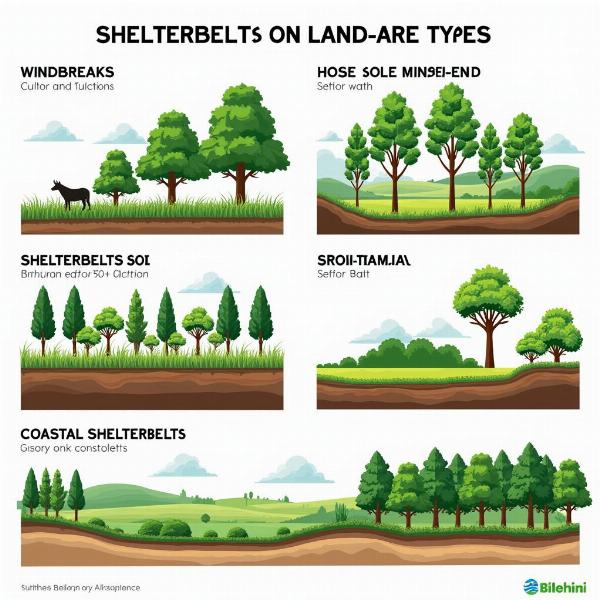Understanding the meaning and significance of shelter belts, particularly within the Indian context, is crucial for sustainable agricultural practices and environmental protection. Shelter belts, known for their ability to mitigate the effects of wind and erosion, play a vital role in preserving and enhancing agricultural productivity. “Shelter belts meaning in hindi” encapsulates the essence of this vital agricultural practice and its translation into a language understood by millions.
Understanding “Shelter Belts Meaning in Hindi”
“Shelter belts meaning in hindi” translates to “रक्षक पट्टी” (rakshak patti) or “हवा-रोधी पट्टी” (hawa-rodhi patti). “Rakshak” means protector, and “patti” means strip or belt, highlighting the protective function of these planted areas. Similarly, “hawa-rodhi” refers to wind-resistant, further emphasizing their role in mitigating wind erosion. The search for “shelter belts meaning in hindi” often stems from a desire to understand the technical term in a familiar language, often driven by the need for practical application in agriculture or environmental projects.
What are the benefits of knowing the Hindi term for shelter belts? Understanding the local terminology can bridge the gap between scientific knowledge and practical implementation, especially when interacting with local communities and farmers. It allows for easier dissemination of information and promotes effective communication about sustainable agricultural practices. This understanding is particularly crucial in India, where agricultural practices are often deeply rooted in tradition and local knowledge.
Different Types of Shelter Belts in India
Shelter belts can be categorized based on their purpose and design. Some common types include:
- Windbreaks: Primarily designed to reduce wind speed and protect crops, livestock, and infrastructure from wind damage.
- Shelterbelts for Soil Conservation: These belts are designed to prevent soil erosion by wind and water. They often include a mix of trees, shrubs, and grasses.
- Coastal Shelterbelts: Planted along coastlines to protect against strong sea winds and saline spray.
- Agroforestry Shelterbelts: These integrate trees with agricultural crops to provide multiple benefits, including improved soil fertility and diversified income.
 Different Types of Shelter Belts
Different Types of Shelter Belts
Why is it important to understand the different types of shelter belts? Identifying the appropriate type of shelter belt for a specific location and purpose is critical for maximizing its effectiveness. Factors like prevailing wind direction, soil type, and local climate play a significant role in selecting the right combination of plant species and design.
The Importance of Shelter Belts for Indian Agriculture
Indian agriculture heavily relies on monsoon rains, which can be erratic. Shelter belts play a vital role in conserving soil moisture by reducing evaporation caused by strong winds. They also protect crops from wind damage and improve microclimate conditions, leading to increased yields. Furthermore, shelter belts can contribute to biodiversity conservation and provide additional income sources for farmers through the harvesting of timber and non-timber forest products.
How can shelter belts help combat climate change? Trees in shelter belts absorb carbon dioxide from the atmosphere, mitigating the effects of climate change. They also contribute to improved air quality and help regulate local temperatures.
Designing and Maintaining Effective Shelter Belts
The design and maintenance of shelter belts require careful planning. Choosing the right plant species adapted to the local environment is crucial. Proper spacing and arrangement of trees and shrubs within the belt are also essential for optimal wind reduction and other benefits. Regular maintenance, including pruning and watering, ensures the long-term health and effectiveness of the shelter belt.
What are some common challenges in maintaining shelter belts? Challenges include ensuring adequate water supply, especially in arid and semi-arid regions, protecting the belts from grazing animals, and managing pests and diseases.
Conclusion
Understanding “shelter belts meaning in hindi” and its broader implications is essential for promoting sustainable agricultural practices in India. Shelter belts provide numerous benefits, including wind protection, soil conservation, improved microclimate, and carbon sequestration. By effectively designing, implementing, and maintaining shelter belts, we can contribute to enhanced agricultural productivity, environmental sustainability, and climate change mitigation. Knowing the local terminology empowers individuals and communities to engage actively in these critical efforts.
FAQ
- What is the main purpose of a shelter belt? The primary purpose of a shelter belt is to reduce wind speed and protect crops, livestock, and infrastructure from wind damage.
- What are the different types of shelter belts used in India? Common types include windbreaks, shelterbelts for soil conservation, coastal shelterbelts, and agroforestry shelterbelts.
- How do shelter belts contribute to soil conservation? They prevent soil erosion by reducing wind and water erosion.
- What are the benefits of shelter belts for Indian agriculture? They conserve soil moisture, protect crops from wind damage, improve microclimate conditions, and contribute to biodiversity conservation.
- How do shelter belts help mitigate climate change? They absorb carbon dioxide from the atmosphere and help regulate local temperatures.
- What are some key considerations for designing and maintaining effective shelter belts? Choosing suitable plant species, proper spacing and arrangement of trees, and regular maintenance are crucial.
- What are some common challenges faced in maintaining shelter belts? Challenges include ensuring adequate water supply, protection from grazing animals, and managing pests and diseases.
Connect with Meaning-Hindi.in for Expert Translation Services
Meaning-Hindi.in provides expert translation services specializing in a wide range of areas, including business, legal, technical, website localization, educational, and specialized content. Our team of experienced translators ensures accurate and culturally sensitive translations between Hindi and other languages. For all your translation needs, contact us at [email protected] or call us at +91 11-4502-7584. Meaning-Hindi.in is your trusted partner for bridging language barriers and facilitating effective communication.